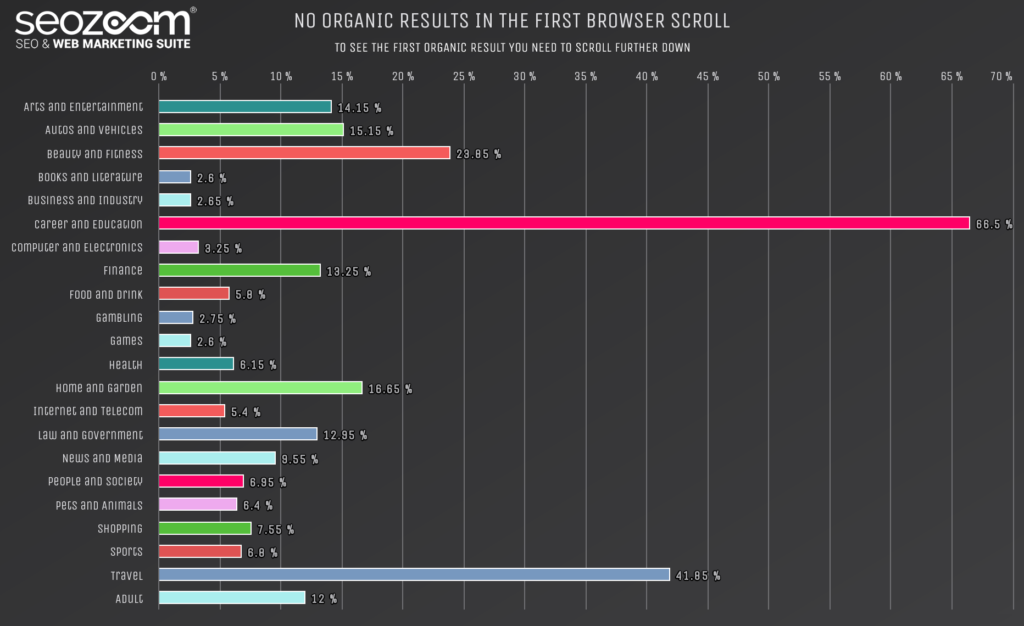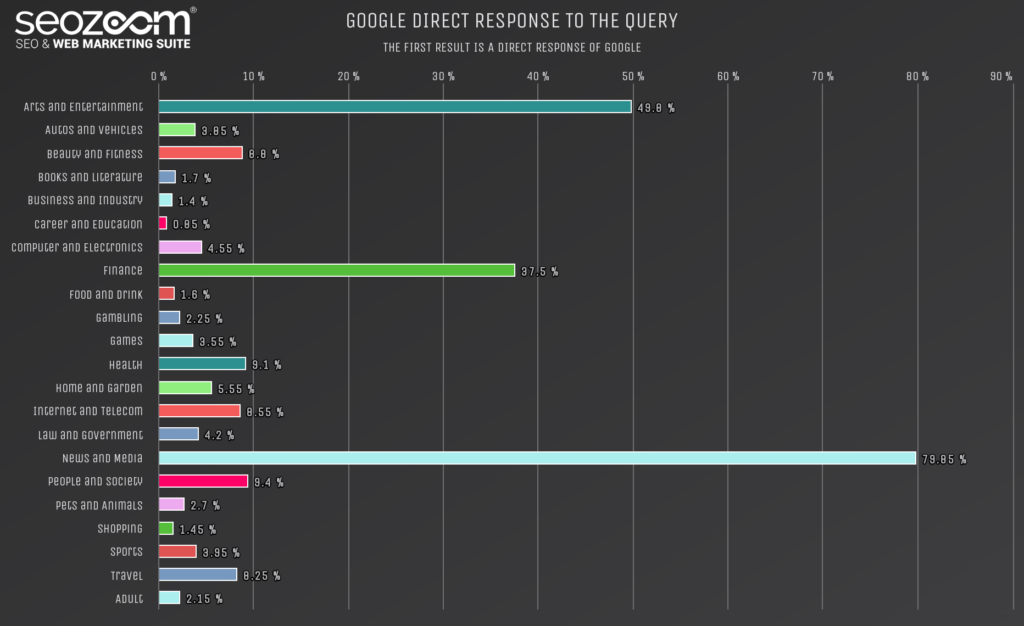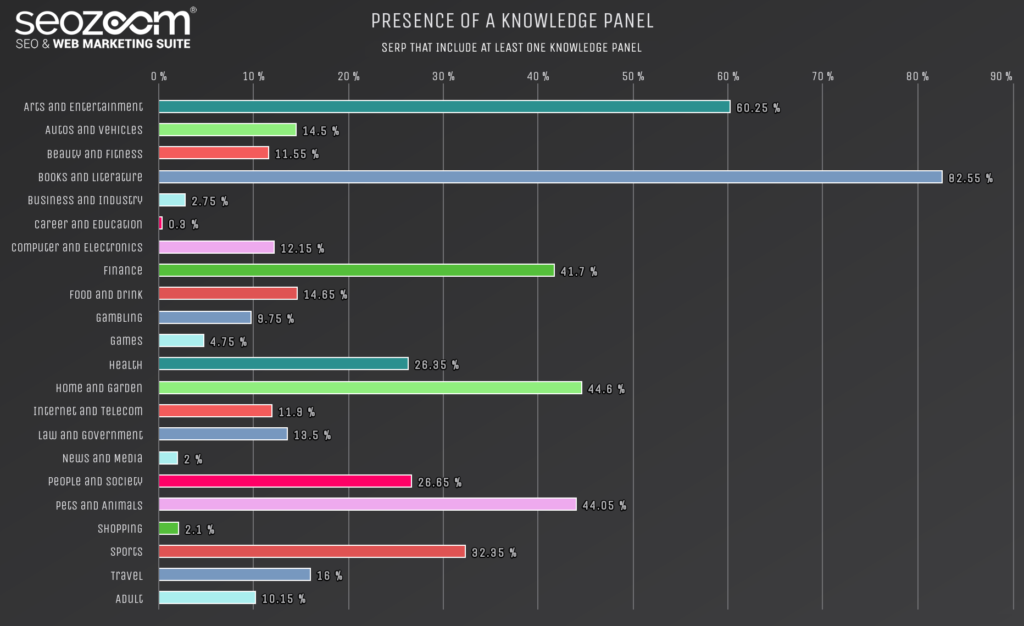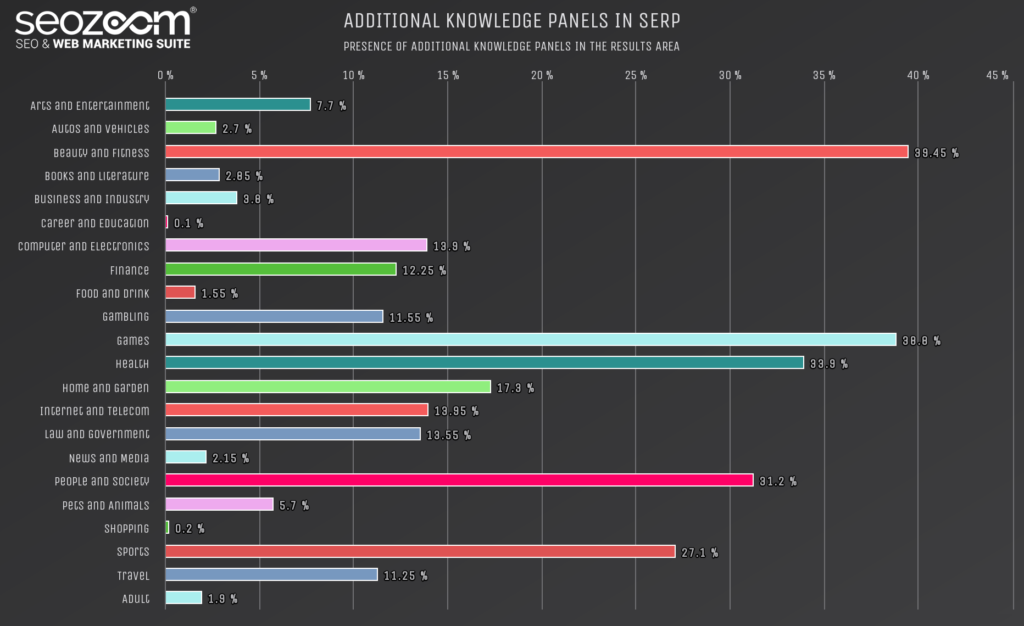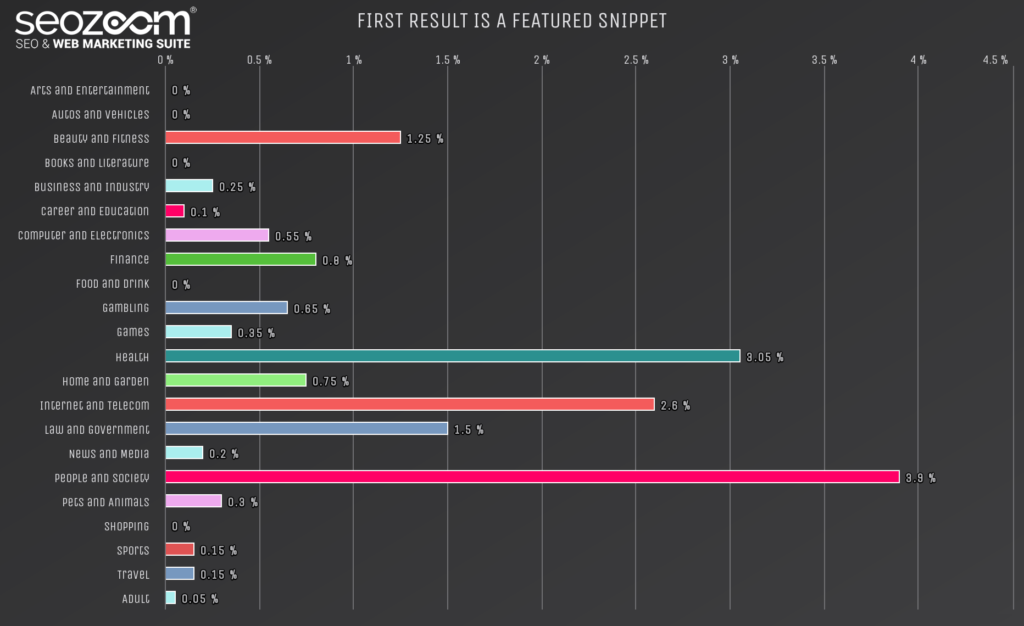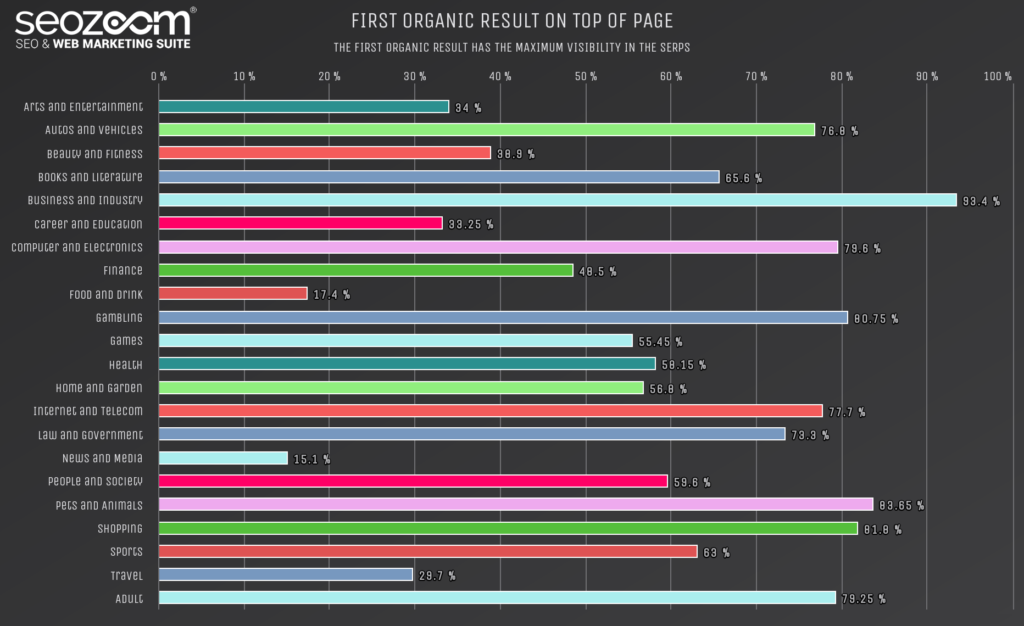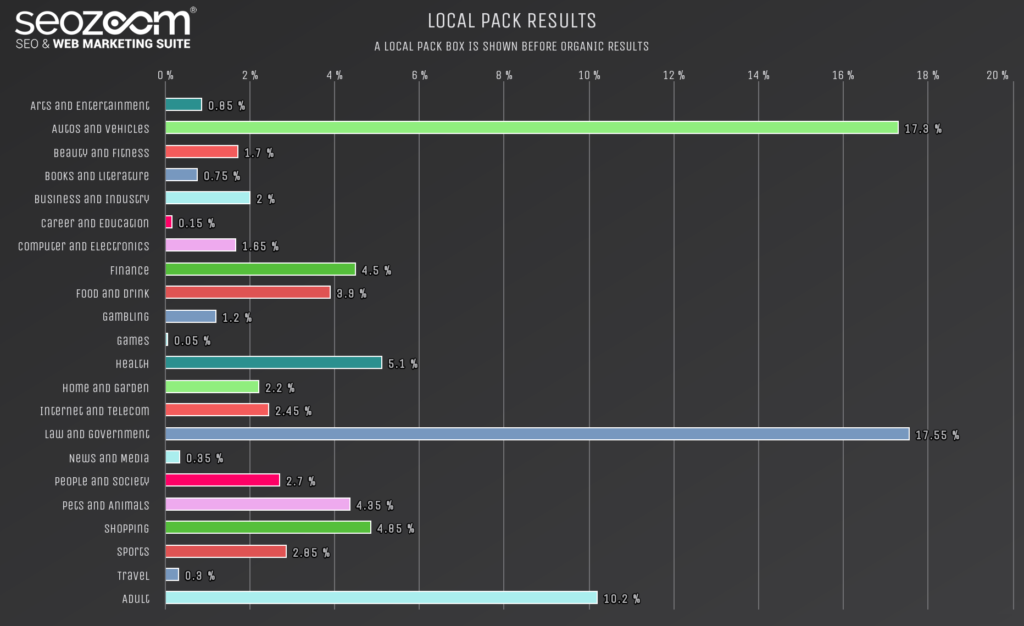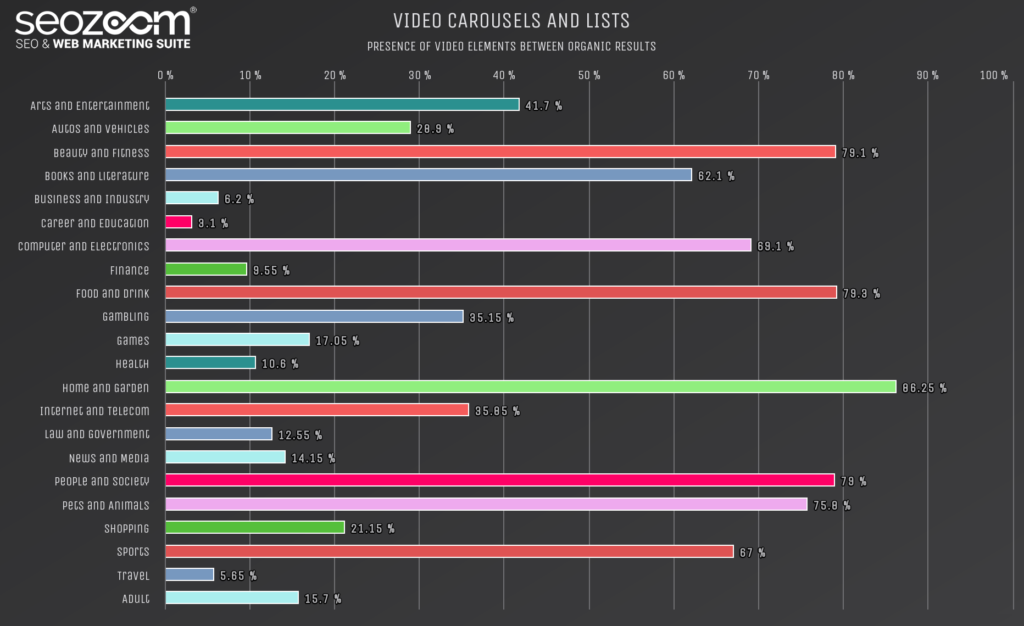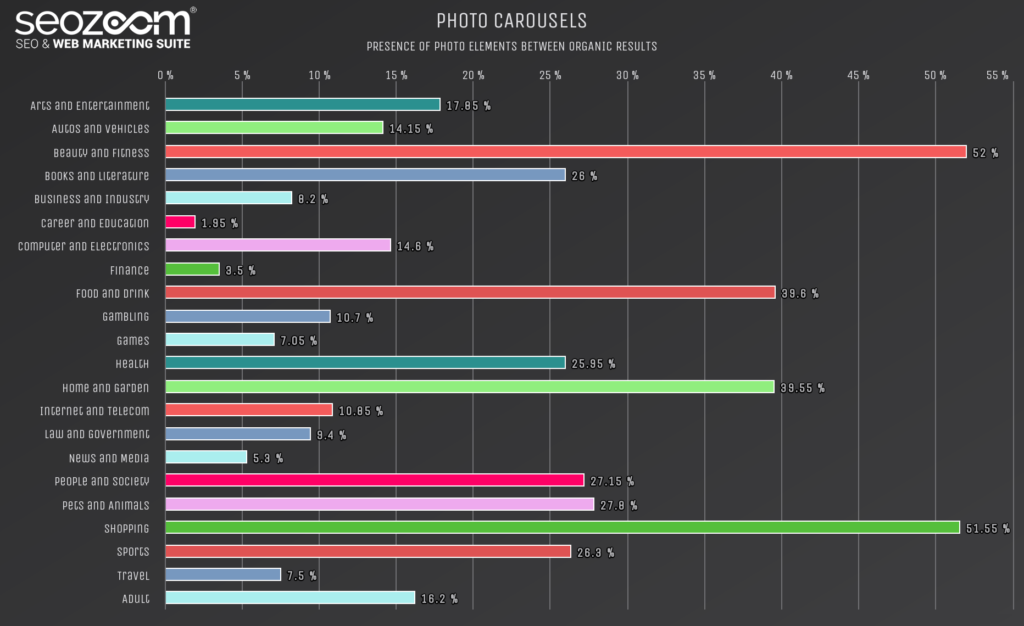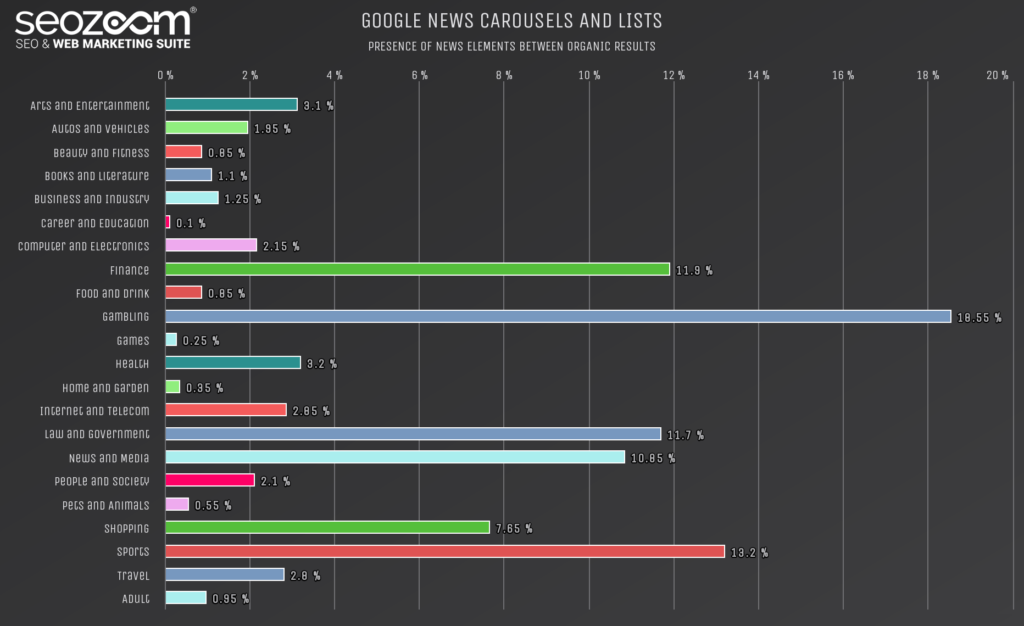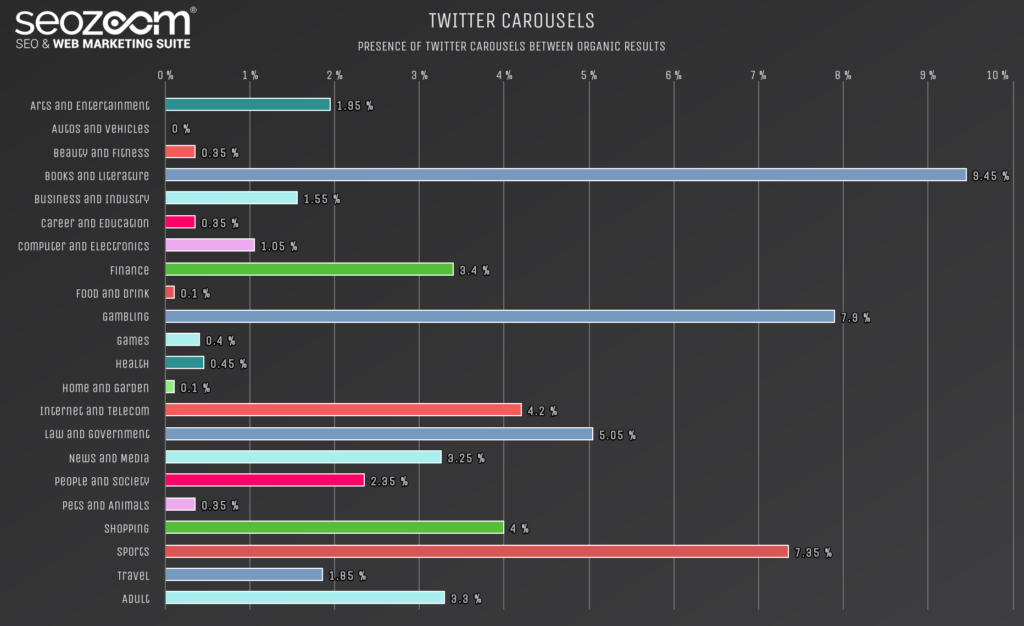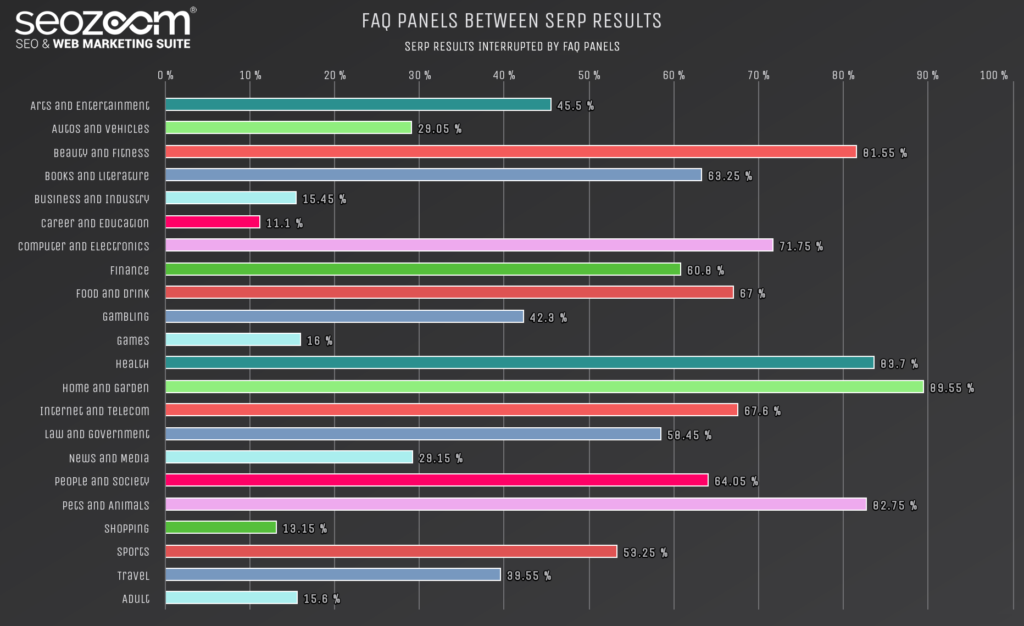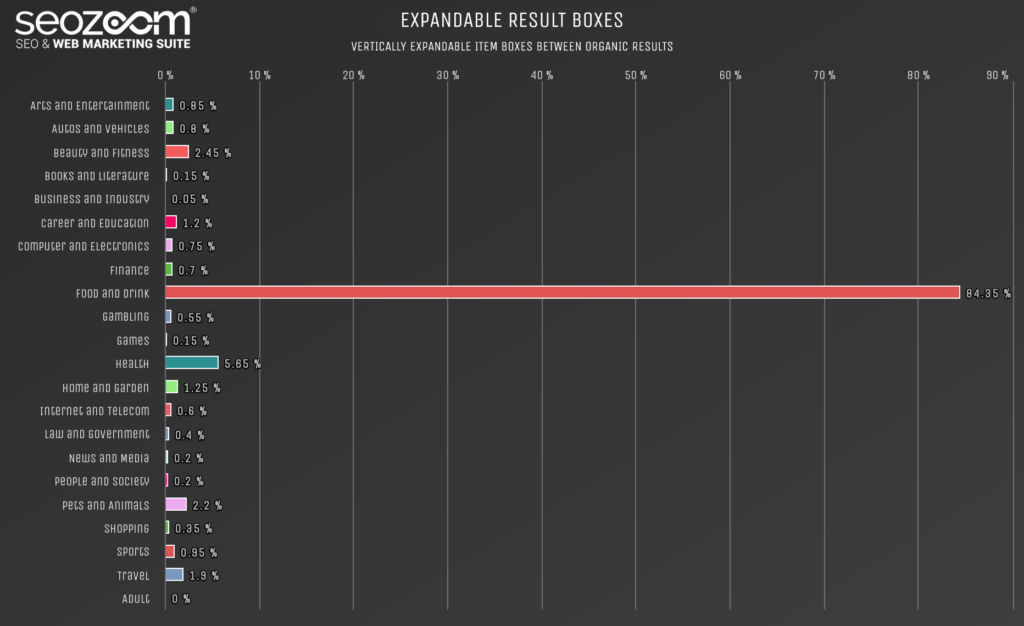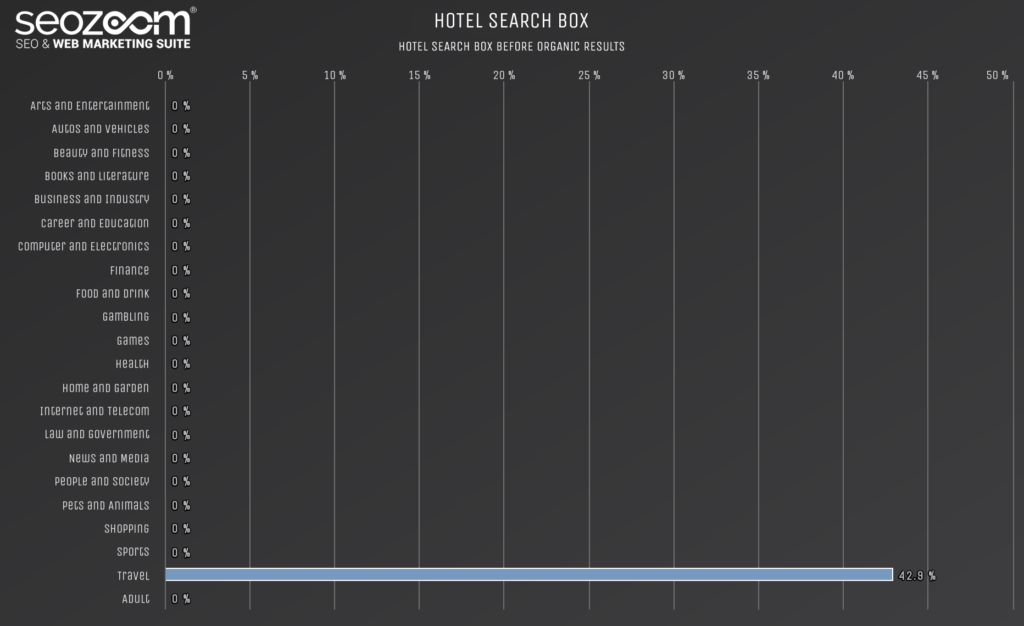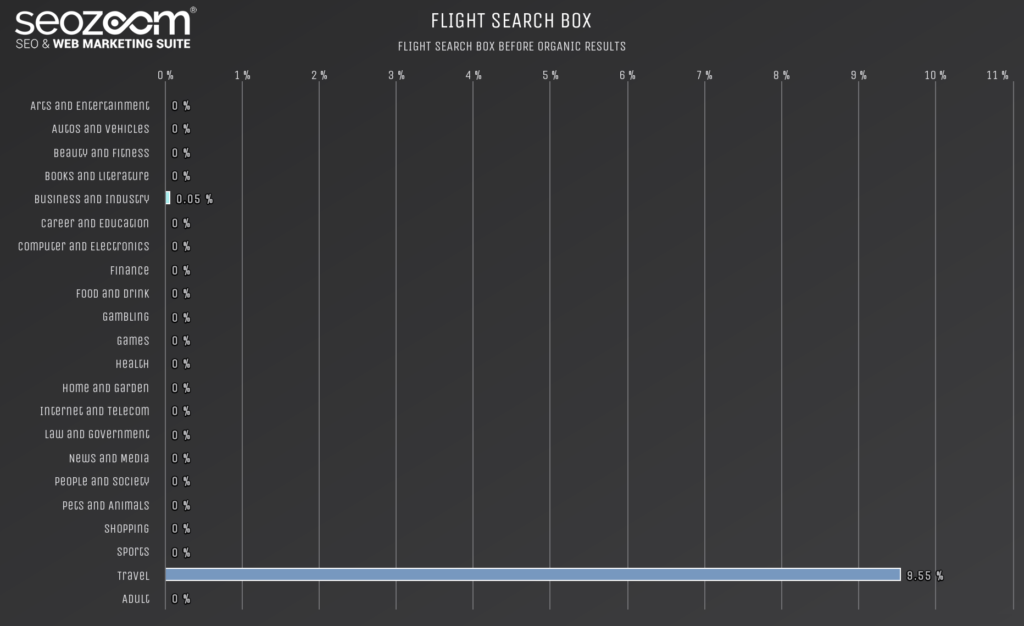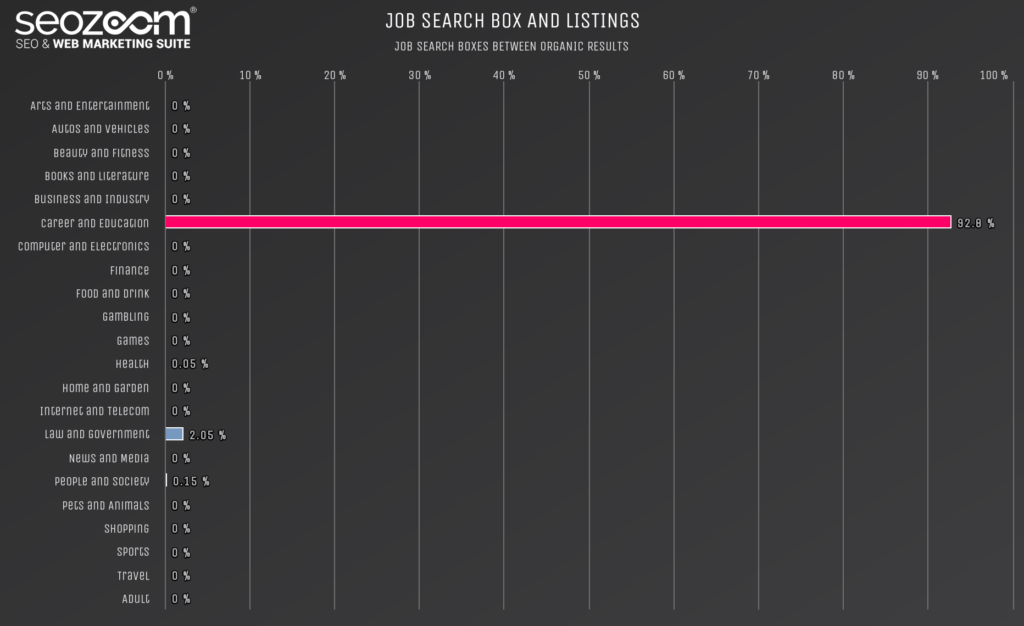How much space Google subtracts from organic results
Where did the blue links on Google go? Among local packs, knowledge panels, direct answer boxes, carousels and featured snippets, it is increasingly difficult to find in a glance the old organic results, the result of both the classification work of the algorithm and SEO efforts.
We tried to give a precise answer to the opening question, by analyzing thousands of keywords and SERPs to determine the actual location of the first organic link, the mythical rank 1 on Google, in all major sectors and industries: what emerges perhaps is not surprising, but it is certainly a resounding confirmation of Google’s intrusiveness, who often occupies much of the SERP with its features and cannibalizes the organic results on the front page.
The methodology of the study
Thanks to SEOZoom’s new SERP analysis engine, we were able to determine how Google behaves with the different industry queries, by examining a dataset of the best 10,000 keywords of each industry on Google UK for desktop.
We have thus analyzed 16 different cases of occupation of the SERPs, reporting for each the differences between sector queries. This allowed us to find out how much space is taken by several Google features and boxes for each niche, the percentage of queries per sector in which the first result is not immediately visible at the first scroll of the user, but also the percentage of news, videos and images.
The collected data describe a clear picture: in almost all sectors Google often occupies much of the SERP with its boxes, relegating organic links to visual placements that are even below the fold and therefore invisible within the first screen.
This is particularly evident in industries such as career and education, where nearly two out of three queries generate a SERP without organic results in the above the fold portion of the page (also due to the presence of the Search for jobs on Google box), or in news and media, where in almost 80 percent of cases direct answer boxes appear, promptly offering users the requested information.
Even more particular is the food and drink sector: if until a few years ago it was dominated by featured snippets, which offered readers a featured result followed by the classic blue links, now instead Google relies on an expandable results box, initially proposing three results at the top that, by clicking on show more, you can precisely expand up to occupy the entire page.
But let’s go see the results for each of the analyzed occurrences.
No organic results above the fold

In two areas such as travel (about 42%) and career and education (even 66,5%) users have to scroll past the first screen of the desktop browser to find the first organic link, as the main part of the visible window is entirely occupied by features, boxes and other Google tools. Things are not going that much better for beauty and fitness (24%) or home and garden (16.65%), which denote a strong incidence of these extra features compared to classic organic results.
If these are the niches most affected by the phenomenon, it can be noted that no sector is really safe: although in a smaller percentage, between 2 and 3% of the cases also the books and literature, business and industry, computer and eletronics, gambling and games queries generate SERPs dominated by Google in the above the fold portion of the page.
Direct answers from Google
This focus indicates even more clearly the propensity of Google to solve the user’s need for information directly on its own page: in sectors such as news and media (even in the 80% of cases) and arts and entertainment (50%) people get a direct answer to their query, with organic results that therefore remain available only to those who have the desire and time to deepen the topic.
The percentage is also very high in the finance sector (37.5%), but it should be noted that the percentages in the sectors that are apparently less affected – like career and education, shopping or food and drinks (respectively 0.85, 1.45 and 1.6%) – are counterbalanced by the presence of other features which still generate the same sliding effect of organic results in less attractive positions.
Presence of knowledge panels
As we know, the knowledge panel is an information tab appearing in a box on the right side of the screen for entity-related searches, with information about biography or history, photos, several links and other data.
Our study reveals that the sector where the appearance of this box is most frequent – attracting the users’ gaze for position and composition – is books and literature, where it is presented in almost 9 out of 10 searches (82,5%); very high are the probabilities of finding a knowledge panel also in arts and literature (60.25%), home and garden and pets and animals (both sectors around 45%).
Again, the lower incidence of this feature in some sectors is motivated by the appearance of other features.
Presence of additional knowledge panels
In addition to the traditional knowledge panel on the right, for some queries Google has decided to add an additional box at the top of the SERP – generally before the organic results, and therefore on a maximum-visibility prime spot.
This is particularly blatant in areas such as beauty and fitness and games, where almost 40% of queries also generates this other box, or in health and people and society, where basically one search out of three determines a SERP consisting of a knowledge panel on the right and an additional box at the top, with the inevitable slip down of all blue links.
Occurrence of featured snippets
Featured snippets are among the most thorny elements of SEO: the special box “that contains the answer Google considers the most accurate in reference to the question asked by a user in Search” (by definition of Google guides) is indeed problematic as it risks to subtract clicks to the site that benefits from them, always to the advantage of the search engine.
The sector in which the presence of featured snippet is higher is people and society (about 4% of queries), followed by health (3%) and Internet and telecom (2.6%). As already mentioned, it should not surprise the 0% of niches such as shopping, food and drinks, arts and literature, auto and vehicles and books and literature: these are areas in which Google has decided to use other tools and features to answer questions from users, avoiding then the resort to featured snippets that, still, up until some time ago were frequent.
First organic result in the top portion of the page
The effect of the various Google features causes, as said, a slip of blue links toward less immediately visible positions of the browser window. This trend is not the same in all sectors and in some cases the first organic result still maintains its maximum visibility on the page – the best case study for SEO users, because the first result really comes out first on the page – while others are more affected by the distractions introduced, which take priority away from links.
In news and media and food and drinks, in particular, the result number one does not appear at the top of the page in almost nine out of 10 queries! And there are many sectors in which the first organic result does not occupy the position of maximum visibility on the page in more than half of the cases.
On the contrary, there is the business and industry niche, where the position number one still has a visual relevance in the 93.4% of cases, but in general it is noted that in all industries it is becoming nearly impossible for a user to find an organic result at first try.
Local pack results
In strong growth is also the local pack section, in which Google – before organic results – shows the local business connected to the query with location map and list of results from Google My Business.
The areas where this feature is more frequent are auto and vehicles and law and government (just over 17% of queries), followed by the adult niche (10%), while the minimum percentages of sectors such as games or career and education are explained, once again, with the predominance of other types of features in those SERP.
Presence of videos
Also increasing is the appearance of videos – in different variants of visualization – among the organic search results: from the carousel with three thumbnails up to the large size preview with integrated player, there are more and more cases in which Google proposes some video resources (as well), in the vast majority of cases coming from YouTube, of course.
The trend is particularly evident in the home and garden sector, where in the almost 90% of cases the SERP presents at least one video, as well as beauty and fitness, food and drinks and people and society, all industries close to 80% of video presence.
Presenza di foto
Similarly, pictures also have a strong impact on the composition of SERPs and often dominate the main screen.
In the case of shopping or beauty and fitness, in particular, more than half of the queries generates photo carousels – both in top position (immediately below the search box) and interspersed with organic results – which are, moreover, expandable to largely occupy the browser window, pushing the blue links further down.
Presence of news features
News and info-related queries result in the appearance of items linked to Google News, such as article carousels, source lists and Top Stories boxes.
The sectors where these features are more frequent are gambling (18.5%), sport (13%), finance and law and government (about 12%).
Occurrence of Twitter Carousels

It does not always appear and does not seem to respect fixed rules, but in any case its presence is more evident in areas such as books and literature (almost 10% of queries), gambling and sport (around 8% of cases).
Occurrence of a FAQ panel among search results
For some time now, Google is increasingly placing the People also ask box or any other kind of FAQ panel among search results: its position is not fixed, because it can appear both in the top part of the page (in evidence compared to links), both at the center (in the middle of the organic results), and finally in a low position (after 10 links), but it should be considered an element of disturbance to the classic consultation of the SERP and the possibility of user clicks.
This box appears in 9 out of 10 queries related to the home and garden sector, and its incidence is higher than 80% even in health, pets and animals and beauty and fitness niches.
Presence of expandable result boxes
We said it earlier, commenting on the absence of featured snippets for the food and drinks sector: Google has introduced other features that occupy the SERPs, and in particular the results boxes that expand with the user click, until basically hiding the classic screen with organic links.
The food sector is the most affected by the phenomenon, which appears in 84.5% of queries (while in other industries the presence of this feature is much less frequent). Probably, Google felt that the result box was a type of display more suited to the needs of desktop users looking for information on power and recipes than the featured snippet previously used.
Occurrence of hotel search boxes
For the sake of completeness, the study has also examined very specific and sectoral features, such as the hotel search boxes that appear for travel queries (and often steal traffic from sites as they promptly meet the people’s needs).
Obviously, other queries do not generate this feature, and the graph shows indeed the 0% of cases.
Presenza di flight search box
In a similar way we also considered the flight search box, which appears in almost 10 percent of the queries related to the travel sector, with which Google meets the user’s request directly in SERP.
A small percentage of these boxes, equal to just 0.05%, also appears for queries related to the business and industry sector.
Occurrence of Job Search boxes and lists
The last graph highlights the predominance of Google for queries related to job search: in the career and education field more than 92% of users find inside SERP a Google element that distracts them from clicking on an organic result.
A small percentage of research in law and governement (2%) and people and society (0.15%) also generates this feature.
Takeaways
These are some of the pills that emerged from this study:
- In some areas Google totally dominates the SERP with its features and does not show organic results in the above the fold part.
- In the news and media and food and drinks sectors, the first organic result does not have the maximum visibility in SERP in the absolute majority of cases.
- In the news and media industry, Google answers directly to the query in nearly 80% of cases.
- In the food and drinks sector Google preferred not to use featured snippets anymore, so to insert expandable result boxes.
- In areas such as home and garden and beauty and fitness SERPs almost always present at least one video.
- The appearance of FAQ panels within the SERP, in non-fixed positions, is constantly growing for almost all sectors.
- Job search is completely dominated by Google features.



